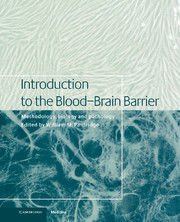Book contents
- Frontmatter
- Contents
- List of contributors
- 1 Blood–brain barrier methodology and biology
- Part I Methodology
- 2 The carotid artery single injection technique
- 3 Development of Brain Efflux Index (BEI) method and its application to the blood–brain barrier efflux transport study
- 4 In situ brain perfusion
- 5 Intravenous injection/pharmacokinetics
- 6 Isolated brain capillaries: an in vitro model of blood–brain barrier research
- 7 Isolation and behavior of plasma membrane vesicles made from cerebral capillary endothelial cells
- 8 Patch clamp techniques with isolated brain microvessel membranes
- 9 Tissue culture of brain endothelial cells – induction of blood–brain barrier properties by brain factors
- 10 Brain microvessel endothelial cell culture systems
- 11 Intracerebral microdialysis
- 12 Blood–brain barrier permeability measured with histochemistry
- 13 Measuring cerebral capillary permeability–surface area products by quantitative autoradiography
- 14 Measurement of blood–brain barrier in humans using indicator diffusion
- 15 Measurement of blood–brain permeability in humans with positron emission tomography
- 16 Magnetic resonance imaging of blood–brain barrier permeability
- 17 Molecular biology of brain capillaries
- Part II Transport biology
- Part III General aspects of CNS transport
- Part IV Signal transduction/biochemical aspects
- Part V Pathophysiology in disease states
- Index
13 - Measuring cerebral capillary permeability–surface area products by quantitative autoradiography
from Part I - Methodology
Published online by Cambridge University Press: 10 December 2009
- Frontmatter
- Contents
- List of contributors
- 1 Blood–brain barrier methodology and biology
- Part I Methodology
- 2 The carotid artery single injection technique
- 3 Development of Brain Efflux Index (BEI) method and its application to the blood–brain barrier efflux transport study
- 4 In situ brain perfusion
- 5 Intravenous injection/pharmacokinetics
- 6 Isolated brain capillaries: an in vitro model of blood–brain barrier research
- 7 Isolation and behavior of plasma membrane vesicles made from cerebral capillary endothelial cells
- 8 Patch clamp techniques with isolated brain microvessel membranes
- 9 Tissue culture of brain endothelial cells – induction of blood–brain barrier properties by brain factors
- 10 Brain microvessel endothelial cell culture systems
- 11 Intracerebral microdialysis
- 12 Blood–brain barrier permeability measured with histochemistry
- 13 Measuring cerebral capillary permeability–surface area products by quantitative autoradiography
- 14 Measurement of blood–brain barrier in humans using indicator diffusion
- 15 Measurement of blood–brain permeability in humans with positron emission tomography
- 16 Magnetic resonance imaging of blood–brain barrier permeability
- 17 Molecular biology of brain capillaries
- Part II Transport biology
- Part III General aspects of CNS transport
- Part IV Signal transduction/biochemical aspects
- Part V Pathophysiology in disease states
- Index
Summary
Overview of quantitative autoradiography
Realizing the diversity in neural function, structure, metabolism, and pathology within the central nervous system, Kety, Sokoloff, and coworkers (Landau et al., 1955; Reivich et al., 1969; Sokoloff et al., 1977; and Sakurada et al., 1978) developed quantitative autoradiography (QAR) and used it to demonstrate variations in cerebral blood flow and glucose utilization not only among brain regions but also within them at the level of nuclei, layers, and tracts. In the extreme, QAR can localize and quantitate 14C-radioactivity with reasonable accuracy in a tissue volume of less than 100 μm x 100 μm x 20 μm when care is taken to minimize intratissue redistribution during and after the experimental period. Because of this ability to localize radioactivity in brain tissue, the measured parameters and functions are often referred to as ‘local,’ e.g. local cerebral blood flow (LCBF) and local cerebral glucose utilization (LCGU). This localizing capability is the major reason for using quantitative autoradiography in animal studies.
In brief, the technique of quantitative autoradiography involves administering a radiotracer into an experimental animal, usually intravenously, taking a series of blood samples for assessing radioactivity, killing the animal, and rapidly removing and freezing the brain.
- Type
- Chapter
- Information
- Introduction to the Blood-Brain BarrierMethodology, Biology and Pathology, pp. 122 - 132Publisher: Cambridge University PressPrint publication year: 1998
- 4
- Cited by



